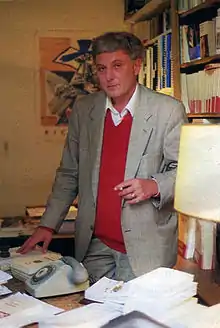Philippe Sollers
Philippe Sollers (French: [sɔlɛʁs]; born Philippe Joyaux 28 November 1936,[1] Bordeaux, France) is a French writer and critic. In 1960 he founded the avant garde literary journal Tel Quel (along with writer and art critic Marcelin Pleynet), which was published by Le Seuil and ran until 1982. Sollers then created the journal L'Infini, published first by Denoel, then by Gallimard with Sollers remaining as sole editor.
Philippe Sollers | |
|---|---|
 | |
| Born | Philippe Joyaux 28 November 1936 Talence, France |
| Nationality | French |
| Occupation | Writer novelist |
| Spouse(s) | |
| French literature |
|---|
| by category |
| French literary history |
| French writers |
|
| Portals |
|
Sollers was at the heart of the period of intellectual fervour in the Paris of the 1960s and 1970s. He contributed to the publication of critics and thinkers such Jacques Derrida, Jacques Lacan, Louis Althusser, and Roland Barthes. Some of them were later described in his novel, Femmes (1983) alongside other figures of French intellectualism active before and after May 1968.
His writings and approach to language were examined and praised by French critic Roland Barthes in his book Writer Sollers.[2]
Sollers married Julia Kristeva in 1967.
Biography
Sollers was born as Philippe Joyaux In Talence, where his family ran the Société Joyaux Frères, the iron factory Recalt producing material for kitchens, metal constructions and machines for the aircraft manufacturer SNCASO under the German military administration in occupied France during World War II.[3] His parents were Octave Joyaux and Marcelle Molinié. He moved to Paris in 1955, studied at the Lycée privé Sainte-Geneviève of Versailles and at the ESSEC Business School.[4]
Work

Following his first novel A Strange Solitude (1958), hailed by François Mauriac and Louis Aragon, Sollers began, with The Park (1961) the experiments in narrative form that would lead to Event (Drame, 1965) and Nombres (1968). Jacques Derrida analyzed these novels in his book Dissemination. Sollers then attempted to counter the high seriousness of Nombres in Lois (1972), which featured greater linguistic vitality through the use of wordplay and a less formal style. The direction taken by Lois was developed through the heightened rhythmic intensity of non-punctuated texts such as Paradis (1981).

Sollers's other novels include Women (1983), Portrait du joueur (1984), Le coeur absolu (1986), Watteau in Venice (1991), Studio (1997), Passion fixe (2000), L'étoile des amants (2002), which have all introduced a degree of realism to his fiction to the extent that they make more recognizable use of plot, character and thematic development. They offer the reader a clear fictional study of the society in which he or she lives by reinterpreting, among other things, the role of politics, media, sex, religion, and the arts.
In all these novels Sollers's interest in Chinese civilization plays an important part. From the late 1960s on, he studied Chinese and employed ideograms increasingly in his writings. He especially exemplifies this view in the subtitle of Lois, a Chinese ideogram representing both "France" and "Law."
His writings bear a particular focus on musicality. Vocalisation, or his preference for the spoken word, is seen a priority for Sollers. The combination of music, voice and theatre is especially found in opera. The kind of opera associated with Sollers should properly be called opera bouffe because of its sense of humour and love of irony: opera bouffe is a comical farcical type of opera from which the genius of Mozart sprang. In many ways Sollers is doing the work of the opera bouffe or drama giocoso in his novels since Women (1983). Since Lois, the writing is musical: the references to the music in these books are innumerable. In Women: "Whoever understands nothing about music, understands nothing about metaphysics."[5]
The focus on the spoken language also draws Sollers toward James Joyce. Sollers is so fascinated by Joyce's style that he and Stephen Heath collaborated to translate Joyce's Finnegans Wake into French. In January 1975, Sollers gave a lecture to an international symposium on Joyce, claiming Finnegans Wake as "the most formidable anti-fascist book produced between the two wars".[6] However, Joyce is much more than poetry for Sollers. Since both were educated by Jesuits, Joyce and Sollers have strong ties to Catholicism. As Sollers indicated in Paradis, Joycean Christianity, like Sollers' Catholicism, involves both the comic and the pathetic.
The novel Paradis has a particular flavour because the narrator is similar to a troubadour singing the story of postmodern times. The self seems to disappear as word games, puns, neologisms and misspellings create a text that is hallucinatory and humorous in its juxtaposition of seemingly incongruous words and phrases. There are constant references to orchestras and symphonies, thus suggesting that there is an innate structure to what appears at first glance to be a chaotic text. The text's life is much like the sexuality of the writer. There is a rhythm, very much like radar or sonar, according to which the text responds to its need to enjoy itself and also to reproduce itself. The physical drives and desires of the human body lead it toward variations of paradise.
His novels Femmes (1983) and Portrait de joueur (1984) have achieved a certain popularity. The first was translated into English as Women by Barbara Bray and published by Columbia University Press (1990). Philip Roth's comment on the cover of Women says that Sollers is a "master of good-natured malice, a kind of happy, lively, benign Céline."[7]
One of the reasons for the popularity of these books by Sollers is the sense of humour he exhibits with his narrative voice about the culture in which the voice thrives.
In his writing, Sollers has a place of predilection, a place that unites together the whole of his personal pantheon: Venice; Da Ponte, Vivaldi, Tiepolo, Tintoretto, Tiziano, Veronese, Monteverdi and then Casanova "the man whose name is synonymous with Venice",[8] Vivant Denon and the Countess Albrizzi. In intimate experiences, expression, erudition, Sollers reveals the splendours of the Serenissima in a very personal Dictionnaire amoureux de Venise (2004).
In 2000 Sollers published Passion fixe, a love story both immoral and moral.
In 2006 he published Une vie divine. The narrator, a professor of philosophy, is entrusted with the task of discovering a world philosophy that would not exclude the religious dimension of humanity. Through his research and discussions with the two women in his life (one intellectual and the other frivolous) he discovers that only one thinker is strong enough to found a project of world philosophy: Nietzsche. In this novel, Philippe Sollers rises against contemporary nihilism – literature which he sees as locked into misfortune and melancholy – with which he contrasts promises of life and happiness. A political and philosophical novel, Une vie divine is both serious and humorous writing about the possibility of happiness, Nietzsche versus Schopenhauer. Its praises of joy alternate with sadness and ambient defeatism.
In 2016, Sollers published the novel Mouvement centring on Hegel's philosophy and biography, with a radical rethinking of time and history.
Sollers also sees himself and his novels in an 18th-century lineage with philosophers of the French Enlightenment such as Diderot and Voltaire, and therefore does not break with all tradition.
Bibliography
Essays
- "Complots – Gallimard, 2016
- "Portraits de femmes" – Flammarion, 2013
- "Fugues" – Gallimard, 2012
- "Discours Parfait" – Gallimard, 2010
- "Vers le Paradis" – Desclée de Brouwer, 2010 (with DVD)
- "Guerres secrètes" – Carnets nord 2007
- "Fleurs" – Hermann éditions 2006
- Dictionnaire amoureux de Venise, 2004
- "Mystérieux Mozart" – Plon 2001
- "Mysterious Mozart" – University of Illinois Press, 2010
- "Éloge de l'Infini" – Gallimard, 2001
- "Francis Ponge" – Seghers éditions, 2001
- "Francesca Woodman" – Scalo Publishers 1998
- "Casanova l'admirable" – Plon 1998
- "Casanova the Irresistible" – University of Illinois Press, 2016
- "La Guerre du Goût" – Gallimard, 1994
- "Liberté du XVIIIème" (Extract from La Guerre du Goût) – Gallimard, 2002
- "Picasso, le héros" – Le cercle d'art 1996
- "Les passions de Francis Bacon" – Gallimard 1996
- "Sade contre l'Être suprême" – Gallimard 1996
- "Improvisations" – Gallimard, 1991
- "De Kooning, vite" – La différence 1988
- "Théorie des Exceptions" – Gallimard, 1985
- "Sur le Matérialisme" – Seuil, 1974
- "L'Écriture et l'Expérience des Limites" – Seuil, 1968
- Writing and the Experience of Limits – Columbia University Press, 1982
- "Logiques" – Seuil, 1968
- "L'Intermédiaire" – Seuil, 1963
- Le Défi – c.1958 (awarded Fénéon Prize, 1958)
Novels
- Désir - Gallimard, to be published in 2020[9]
- Le Nouveau - Gallimard, 2019
- Centre – Gallimard, 2018
- Beauté – Gallimard, 2017
- Mouvement – Gallimard, 2016
- L'École du Mystère – Gallimard, 2015
- Médium – Gallimard, 2014
- L'Éclaircie – Gallimard, 2012
- Trésor d'Amour – Gallimard, 2011
- Les Voyageurs du temps – Gallimard, 2009
- Un vrai roman, Mémoires – Plon 2007
- Une Vie Divine – Gallimard, 2006
- L'Étoile des Amants – Gallimard, 2002
- Passion Fixe – Gallimard, 2000
- Un amour américain – Mille et une nuits, 1999
- Studio – Gallimard, 1997
- Le cavalier du Louvre, Vivant Denon – Plon 1995
- Le Secret – Gallimard, 1993
- La Fête à Venise – Gallimard, 1991
- Watteau in Venice -Scribner's, 1994
- Le Lys d'Or – Gallimard, 1989
- Les Folies Françaises – Gallimard, 1988
- Le Cœur Absolu – Gallimard, 1987
- Paradis 2 – Gallimard, 1986
- Portrait du Joueur – Gallimard, 1984
- Femmes – Gallimard, 1983
- Women – Columbia UP, 1990
- Paradis – Seuil, 1981
- H – Seuil, 1973
- Lois – Seuil, 1972
- Nombres – Seuil, 1966
- Drame – Seuil, 1965
- Event – Red Dust, 1987
- Le Parc – Seuil, 1961
- The Park – Red Dust, 1986
- Une Curieuse Solitude – Seuil, 1958
- A Strange Solitude – Grove Press, 1959
Interviews
- Contre-attaque – Grasset, 2016
- L'Évangile de Nietzsche – Cherche Midi, 2006
- Poker (interviews with Ligne de risque)- Gallimard, 2005
- Voir écrire (with Christian de Portzamparc) – Calmann-Levy, 2003
- La Divine Comédie – Desclée de Brouwer, 2000
- Le Rire de Rome – Gallimard, 1992
- Vision à New York – Grasset, 1981
- Entretiens avec Francis Ponge – Seuil, 1970
Translations in English
- Casanova the Irresistible – University of Illinois Press, 2016
- H – Equus Press, 2015
- Mysterious Mozart – University of Illinois Press, 2010
- Writing and Seeing Architecture (with Christian de Portzamparc) – University Of Minnesota Press, 2008
- Watteau in Venice – Scribner's, 1994
- Women – Columbia University Press, 1990
- Event – Red Dust, 1987
- The Park – Red Dust, 1986
- Writing and the Experience of Limits – Columbia University Press, 1983
- A Strange Solitude – Grove Press, 1959
Influences and tributes
- Sollers appears as a character in Philip Roth's Operation Shylock (1993), Michel Houellebecq's novel Atomised (1998) and several novels by Marc-Édouard Nabe, including L'Homme qui arrêta d'écrire (2010).
- His writings inspired the eponymous Japanese rock band Sollers.
- A character based on Sollers features in Laurent Binet's 2015 novel La Septième Fonction du langage (Grasset), translated into English as The Seventh Function of Language (2017).[10][11]
Notes
- "1936, 28 novembre – Philippe Sollers/Pileface". pileface.com. Retrieved 17 April 2018.
- Barthes, Roland (1987). Writer Sollers. Bloomsbury. ISBN 9780485113372.
- Usine de ferblanterie Recalt ; usine de chaudronnerie Boyer S.A., Actuacity
- Anna Topaloff, " ESSEC, la business school qui mène à tout ", GQ, juillet 2015, pages 54–58.
- Philippe Sollers, Women, translated by Barbara Bray, Columbia, 1990 ISBN 9780704327917
- The Reception of James Joyce in Europe, A&C Black, 2009 (ISBN 9781847146014)
- Philip Roth, "Anybody out for a good time should read Philippe Sollers", in Comments on Women, Columbia University Press, 1990 (ISBN 0704327910)
- Philippe Sollers, "Casanova l'admirable", Gallimard, 2000 (ISBN 9782070408917)
- "Désir - Blanche - GALLIMARD - Site Gallimard". www.gallimard.fr. Retrieved 12 January 2020.
- Elkin, Lauren (12 May 2017). "The 7th Function of Language by Laurent Binet review – who killed Roland Barthes?". The Guardian. Retrieved 19 March 2018.
- Dames, Nicholas (16 August 2017). "A Postmodern Buddy-Cop Novel Sends Up the World of Semiotics". The New York Times. ISSN 0362-4331. Retrieved 19 March 2018.
Further reading and literary criticism
- Roland Barthes, Writer Sollers, 1979 (ISBN 0-485-11337-6)
- Jacques Derrida, Dissemination, 1983 (ISBN 0-226-14334-1)
- Julia Kristeva, Polylogue, 1977 (ISBN 2-02-004631-8)
- Michel Foucault, Distance, aspect, origine : Philippe Sollers, Critique n° 198, November 1963
- Malcolm Charles Pollard, The novels of Philippe Sollers : Narrative and the Visual, 1994 (ISBN 90-5183-707-0)
- Philippe Forest, Philippe Sollers, 1992 (ISBN 2-02-017336-0)
- Eric Hayot, Chinese Dreams: Pound, Brecht, Tel Quel, 2004 (ISBN 0-472-11340-2)
- Hilary Clarke, The Fictional Encyclopaedia: Joyce, Pound, Sollers, 1990 (ISBN 0-8240-0006-4)
- Alex Gordon,‘Roland Barthes’ Sollers Ēcrivain and the Problem of the Reception of Philippe Sollers’ L’écriture percurrente’, Journal of the Institute of Humanities, Seoul National University, No. 48, February 2002, pp. 55–83.
- Sade's Way, Sollers on Sade, video documentary on ParisLike, 2013 (ISSN 2117-4725)
External links
| Wikiquote has quotations related to: Philippe Sollers |